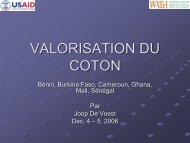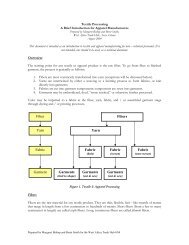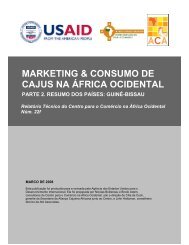Shea Butter A Guide to Production and Marketing - AGOA Export ...
Shea Butter A Guide to Production and Marketing - AGOA Export ...
Shea Butter A Guide to Production and Marketing - AGOA Export ...
Create successful ePaper yourself
Turn your PDF publications into a flip-book with our unique Google optimized e-Paper software.
Peace Corps Ghana Version 1, March 2008<br />
It may seem like a lot of hard work, but in the end it pays off when you see a<br />
container of beautiful creamy, pure shea butter.<br />
2: Uses of <strong>Shea</strong><br />
<strong>Shea</strong> has so many uses that we turned <strong>to</strong> the experts at Cocoa Research Institute of<br />
Ghana. The following is an excerpt from a case study done in 2002:<br />
The shea nut serves as one of the main sources of livelihood for the rural women <strong>and</strong><br />
children who are engaged in its gathering. <strong>Shea</strong> butter is the main edible oil for the<br />
people of northern Ghana, being the most important source of fatty acids <strong>and</strong> glycerol<br />
in their diet. It is an unguent for the skin. It also has anti-microbial properties, which<br />
gives it a place in herbal medicine. It is also used in the pharmaceutical <strong>and</strong> cosmetic<br />
industries as an important raw material <strong>and</strong>/or a precursor for the manufacture of<br />
soaps, c<strong>and</strong>les, <strong>and</strong> cosmetics. <strong>Shea</strong> butter is used as a sedative or anodyne for the<br />
treatment of sprains, dislocations <strong>and</strong> the relief of minor aches <strong>and</strong> pains. Other<br />
important uses include its use as an anti-microbial agent for promotion of rapid<br />
healing of wounds, as a pan-releasing agent in bread baking <strong>and</strong> as a lubricant for<br />
donkey carts. Its by-products, the brown solid that is left after extracting the oil <strong>and</strong><br />
the hard protective shell, are used as a water-proofing material on the walls of mudbuildings<br />
<strong>to</strong> protect them from the eroding forces of the wind <strong>and</strong> rain. Poor quality<br />
butter is not only applied <strong>to</strong> earthen walls but also <strong>to</strong> doors, windows, <strong>and</strong> even<br />
beehives as a waterproofing agent (March<strong>and</strong>, 1988). In a traditional setting, shea<br />
butter of poor quality is used as an illuminant (or fuel, in lamps or as c<strong>and</strong>les).<br />
Traditional Products<br />
Oil has played an important part in the local economies in west <strong>and</strong> central sub-<br />
Saharan Africa for centuries. It is reported that the initial traditional roles have not<br />
changed significantly since 1830, when the French explorer Roger Caillie described<br />
them during his trek across West Africa. In Roger Caillie’s own words as reported in<br />
Hall et al., 1996, “the indigenous people trade with it, they eat it <strong>and</strong> rub their bodies<br />
with it; they also burn it <strong>to</strong> make light; they assure me that it is a very beneficial<br />
remedy against aches <strong>and</strong> pains <strong>and</strong> sores <strong>and</strong> wounds for which it is applied as an<br />
unguent”. Today the shea tree produces the second most important oil crop in Africa<br />
after oil palm (Poulsen, 1981), but as it grows in areas unsuitable for palm, it takes on<br />
primary importance in West Africa, <strong>and</strong> in regions where annual precipitation is less<br />
than 1000mm of rainfall. However, it loses popularity in urban areas within these<br />
regions due <strong>to</strong> the pungent odor it emits, should it become rancid (Ayeh, 1981b).<br />
Other Traditional Uses of <strong>Shea</strong> butter<br />
As a cosmetic, it is used as a moisturizer, for dressing hair (Dalziel, 1937, Ezema &<br />
Ogujiofor, 1992) <strong>and</strong> for protection against the weather <strong>and</strong> sun. It is used as a rub <strong>to</strong><br />
relieve rheumatic <strong>and</strong> joint pains <strong>and</strong> is applied <strong>to</strong> activate healing in wounds <strong>and</strong> in<br />
cases of dislocation, swelling <strong>and</strong> bruising. It is widely used <strong>to</strong> treat skin problems<br />
Page 7 of 28









